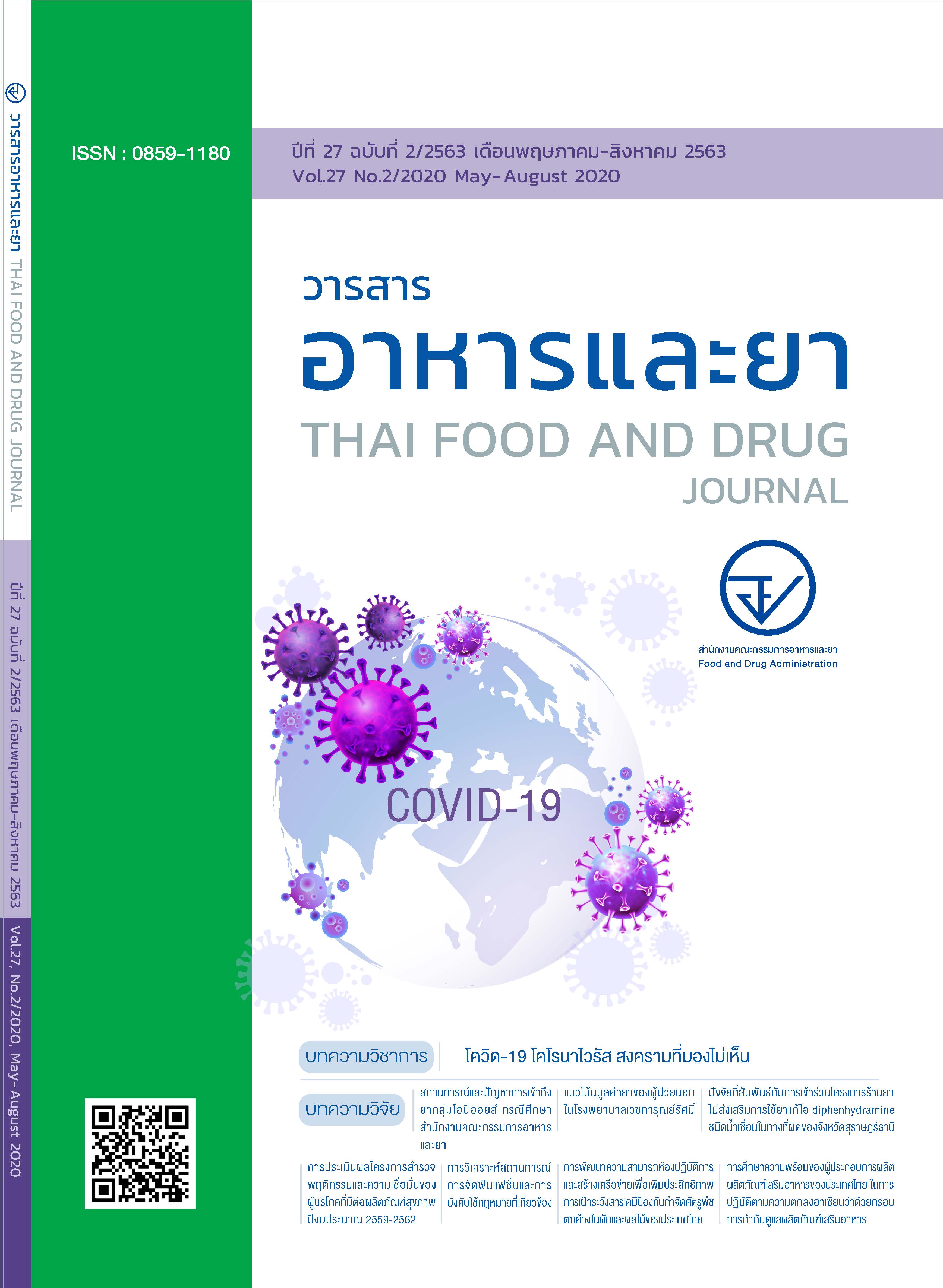การพัฒนาความสามารถห้องปฏิบัติการและสร้างเครือข่ายเพื่อเพิ่มประสิทธิภาพการเฝ้าระวัง สารเคมีป้องกันกำจัดศัตรูพืชตกค้างในผักและผลไม้ของประเทศไทย
Main Article Content
บทคัดย่อ
การตรวจเฝา้ ระวังการตกคา้ งสารเคมีปอ้ งกันกำจัดศัตรูพืชในผักและผลไมเ้ พื่อคุ้มครองผู้บริโภคจำเปน็ ตอ้ ง
ดำเนินการอย่างต่อเนื่องเพื่อประเมินสถานการณ์จัดการความเสี่ยงผลกระทบต่อผู้บริโภค ซึ่งขอบข่ายชนิดสาร
ที่ตรวจวิเคราะห์ถือว่าเป็นประเด็นสำคัญที่ส่งผลต่อประสิทธิภาพการเฝ้าระวังโดยตรง ดังนั้นคณะผู้วิจัยจึงร่วมกัน
วางแผนพัฒนาขีดความสามารถห้องปฏิบัติการจากขอบข่ายการวิเคราะห์เดิมที่ครอบคลุมสารเพียง 62 ชนิด
ให้เพิ่มขึ้นในช่วงปี 2558-2561 โดยวางเป้าหมายขอบข่ายชนิดสารที่จำเป็นในกลุ่มสารที่มีรายงานตรวจพบ
การตกค้างและชนิดสารมีค่ากำหนดตามกฎหมาย จัดเป็นกลุ่มสารเฝ้าระวังในระดับพื้นฐานและในระดับกลาง
โดยในปี 2559 สามารถพัฒนาวิธีวิเคราะห์ multi-residue methods ในการตรวจกลุ่มสารเฝ้าระวังในระดับ
พื้นฐานได 132 ชนิด โดยใชเ้ ครื่องมือ GC-MS/MS และ HPLC และในป 2561 สามารถตรวจวิเคราะหก์ ลุ่มสารเฝา้ ระวัง
ในระดับกลาง 250 ชนิด โดยใช้เครื่องมือ GC-MS/MS และ LC-MS/MS ซึ่งได้นำวิธีที่พัฒนามาใช้ในสำรวจผักและ
ผลไม้สดกลุ่มเสี่ยงพบว่า มีความสามารถของการตรวจคัดกรองตัวอย่างไม่ผ่านมาตรฐานเพิ่มขึ้นเมื่อเพิ่มขอบข่าย
ของการวิเคราะห์ อย่างไรก็ตามเมื่อนำข้อมูลมาเปรียบเทียบความสามารถการคัดกรองตัวอย่างโดยใช้ขอบข่าย
การวิเคราะห์สาร 132 ชนิด จะพบว่ามีตัวอย่างที่ไม่ผ่านมาตรฐานคิดเป็นร้อยละ 85.6 ของตัวอย่างที่ตรวจในขอบข่าย
สาร 250 ชนิด จากข้อมูลทำให้เห็นว่าการจัดกลุ่มสารเฝ้าระวังในระดับพื้นฐานและในระดับกลางจะเป็นแนวทาง
ในการพิจารณาขอบข่ายการวิเคราะห์ที่มีความคุ้มค่าสมประโยชน์สำหรับโครงการสำรวจหรือเฝ้าระวังเพื่อนำ
74 THAI FOOD AND DRUG JOURNAL : MAY-AUGUST 2020
ผลวิเคราะห์ไปใช้งาน นอกจากนั้นได้ร่วมมือกับศูนย์วิทยาศาสตร์การแพทย์บูรณาการพัฒนาศักยภาพห้องปฏิบัติการ
ตั้งแต่ปี 2559 สร้างเครือข่ายห้องปฏิบัติการในส่วนภูมิภาคเพื่อรองรับการตรวจเฝ้าระวังผักและผลไม้ในระดับพื้นที่
ได้เพิ่มขึ้น โดยใช้กระบวนการพัฒนาแบบมีส่วนร่วมในการวางแผนปฏิบัติการประจำปี แลกเปลี่ยนเรียนรู้ถ่ายทอด
เทคโนโลยีการวิเคราะห์ ติดตามประเมินผลด้วยการจัดแผนทดสอบความชำนาญ และส่งเสริมศูนย์วิทยาศาสตร์
การแพทย์เป้าหมายทั้ง 4 ภูมิภาค ให้มีการพัฒนาความสามารถอย่างต่อเนื่อง โดยวางเป้าหมายให้เครือข่ายสามารถ
บริการตรวจวิเคราะห์กลุ่มสารเฝ้าระวังในระดับพื้นฐานในพื้นที่รับผิดชอบได้ในปี 2563
Article Details
เอกสารอ้างอิง
2. กระทรวงสาธารณสุข. ประกาศกระทรวงสาธารณสุข เลขที่ 386 พ.ศ. 2560 เรื่อง กำหนดวิธีการผลิตเครื่องมือ เครื่องใช้ในการผลิตและการเก็บรักษา
ผักหรือผลไม้สดบางชนิด และการแสดงฉลาก.ราชกิจจานุเบกษา เล่ม 134, ตอนพิเศษ 211 ง (ลงวันที่ 25 สิงหาคม 2560).
3. กระทรวงสาธารณสุข. ประกาศกระทรวงสาธารณสุขฉบับ 387 พ.ศ. 2560 เรื่อง อาหารที่มีสารพิษตกค้าง.ราชกิจจานุเบกษา เล่ม 134, ตอนพิเศษ 228 ง
(ลงวันที่ 18 กันยายน 2560).
4. สำนักควบคุมพืชและวัสดุการเกษตร. กรมวิชาการเกษตร. รายงานสรุปการนำเข้าวัตถุอันตรายทางการเกษตร. [อินเทอร์เน็ต]. [เข้าถึงเมื่อ 20 เม.ย.
2563]. เข้าถึงได้จาก: http://www.doa.go.th/ard/?page_id=386
5. กระทรวงสาธารณสุข. ประกาศกระทรวงสาธารณสุขพ.ศ. 2554 เรื่องอาหารที่มีสารพิษตกค้าง. ราชกิจจานุเบกษา เล่ม 128, ตอนพิเศษ 59 ง (ลงวันที่ 16
พฤษภาคม 2554).
6. Joint FAO/WHO Food Standard ProgrammeCodex Alimentarius Commission. Report of the 48th session of the Codex committee
on pesticide residues; 25 - 30 April 2016;Chongqing, China.
7. กองโรคจากการประกอบอาชีพ. โรคจากการประกอบอาชีพภาคเกษตร. สารเคมีกำจัดศัตรูพืชและผลกระทบตอ่ สุขภาพ. [อินเทอรเ์ น็ต]. [เขา้ ถึงเมื่อ 16 ธ.ค. 2562].เข้าถึงได้จาก: http://envocc.ddc.moph.go.th/contents/view/106
8. George W and Latimer JR. Official Methods of Analysis of AOAC International, 20th ed. Rockville: AOAC International; 2016.
9. ศศิวิมล จุลศิลป์. การพัฒนารูปแบบการมีส่วนร่วมของชุมชนในการนำภูมิปัญญาท้องถิ่นมาใช้จัดการศึกษาตามปรัชญาของเศรษฐกิจพอเพียงในสถานศึกษาขั้นพื้นฐาน: การประยุกต์ใช้กระบวนการเอไอซี.Suranaree Journal of Social Science 2010; 4:17-31.
10. Suntudrob J, Jongmevasna W, PayananT, Srikote T, Wittayanan W. Monitoring of pesticide residues in domestic vegetables in Thailand during 2015. Asia-Pacific Journal of Science and Technology 2018; 23:1-8.
11. European Union Reference Laboratory.EURL-FV (2010-M1) Multiresidue Method using QuEChERS followed by GC-QqQ/MS/MS and LC-QqQ/MS/MS for Fruits and Vegetables. [Internet]. [cite 2019 Nov 10]. Available from:
https://www.eurl-pesticides.eu/library/docs/fv/CRLFV_Multiresidue_methods.pdf
12. European Union Reference Laboratory.Analysis of Acidic Pesticides using QuEChERS (EN15662) and acidified QuEChERS method.
[Internet]. 2015. [cite 2019 Nov 10]. Availablefrom: https://www.eurl-pesticides.eu/userfiles/file/EurlSRM/EurlSrm_Observations_AcidicPesticides.pdf
13. สำนักคุณภาพและความปลอดภัยอาหาร. รายงานสรุปผลการดำเนินงานโครงการบูรณาการอาหารปลอดภัย (Food Safety) ประจำปีงบประมาณ 2559. [อินเทอร์เน็ต]. 2559. [เข้าถึงเมื่อ 16 ธ.ค.2562]. เข้าถึงได้จาก: http://bqsf.dmsc.moph.go.th/bqsfWeb/index.php/food-safety-project59/
14. สำนักคุณภาพและความปลอดภัยอาหาร. รายงานสรุปผลการดำเนินงานโครงการบูรณาการอาหารปลอดภัย (Food Safety) ประจำปีงบประมาณ 2561. กรุงเทพฯ: ศูนย์การพิมพ์แก่นจันทร์; 2562.
15. เครือข่ายเตือนภัยสารเคมีกำจัดศัตรูพืช. ผลการสุ่มตรวจสารพิษตกค้างในผักผลไม้ปี 2562. [อินเทอร์เน็ต]. 2562. [เข้าถึงเมื่อ 10 พ.ย. 2562].เข้าถึงได้จาก: https://www.thaipan.org/wpcontent/uploads/2019/pesticide_doc58.pdf
16. สำนักคุณภาพและความปลอดภัยอาหาร. โครงการพัฒนาขีดความสามารถและเครือข่ายห้องปฏิบัติการเพื่อส่งเสริมสนับสนุนอุตสาหกรรมและเฝ้าระวังผลิตภัณฑ์สุขภาพของประเทศ ปีงบประมาณ 2561.[อินเทอร์เน็ต]. 2562. [เข้าถึงเมื่อ 16 ธ.ค. 2562].
เข้าถึงจาก: http://bqsf.dmsc.moph.go.th/bqsfWeb/wp-content/uploads/2017/Publish/annual_report/Annaul%20Report%202561.pdf


